Posted by: Northwest Eye in General on October 8, 2025
Overview
Medicaid coverage for eye exams can vary greatly depending on where you live. Some states offer robust support, while others may impose restrictions or even lack coverage entirely. We understand that navigating these differences can be overwhelming.
It’s important to recognize the significance of understanding local policies and eligibility requirements. Many individuals may face barriers to accessing the eye care services they need, especially in areas where Medicaid support for routine examinations and corrective lenses is limited. We want to assure you that you are not alone in facing these challenges.
By familiarizing yourself with the specifics of your state’s Medicaid program, you can better advocate for your health and well-being. Remember, we are here to help you through this process, ensuring you receive the necessary care you deserve.
Introduction
Navigating the complexities of healthcare can feel overwhelming, especially when trying to understand the specifics of Medicaid coverage for eye exams. We understand that millions of individuals rely on this program, making the question of whether Medicaid covers essential eye care services more critical than ever.
This article will explore the nuances of Medicaid’s eye exam coverage, helping you understand what you can expect regarding:
- Eligibility
- Frequency of services
- Disparities that may exist across different states
As the healthcare landscape evolves, it’s common to wonder how you can ensure you are receiving the eye care you deserve. We are here to help you through this process.
Northwest Eye: Comprehensive Eye Care Services Covered by Medicaid
At Northwest Eye, we understand that navigating eye care can be overwhelming. That’s why we offer a wide range of eye care services, and we can help you understand if Medicaid covers eye exams. Our services include:
- Comprehensive eye examinations
- Cataract procedures
- Therapies for conditions such as glaucoma, dry eye, and astigmatism
- LASIK
- Specialized care for children
We are dedicated to using the latest methods and providing personalized attention to ensure you receive the treatments you need, all while making the most of your health benefits. It’s common to have questions about your eye health, and we encourage you to seek professional diagnosis and care. We are here to help you through this process and support you every step of the way.
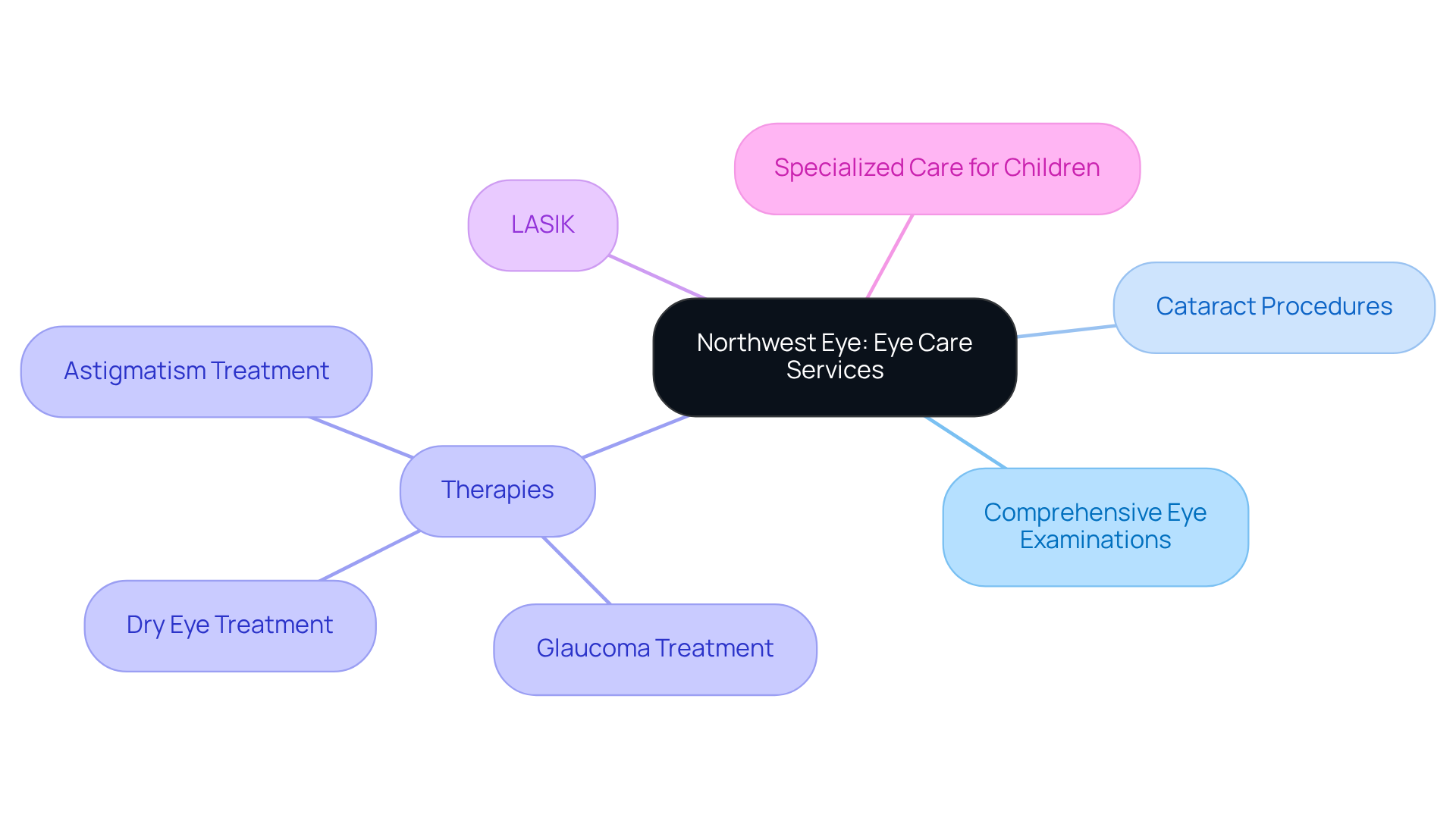
Medicaid Coverage: What Eye Exams Are Included?
A common question is, does Medicaid cover eye exams, which typically include essential vision assessments and screenings for various eye diseases? These exams encompass comprehensive dilated eye exams and refraction tests, both crucial for determining the correct prescription for glasses or contact lenses. However, we understand that the level of insurance can greatly vary from region to region, making it essential for you to verify your individual benefits.
At present, only a portion of regions offer extensive support for these vital services. For example, a study showed that 6.5 million individuals enrolled in government health programs live in areas lacking support for routine adult eye examinations, while 14.6 million reside in regions without assistance for eyeglasses. Significantly, in 12 regions, eye examinations were not included under fee-for-service healthcare policies. This disparity highlights the urgent need for policy reforms to ensure equitable access to vision care, particularly regarding whether Medicaid covers eye exams.
Regarding refraction tests, only a small proportion of regions incorporate them within governmental healthcare support, further complicating access for patients needing these evaluations. Maine, for instance, has one of the most limiting policies, providing glasses assistance only once in a lifetime for individuals with strong prescriptions. This positions it among the regions with the most restrictive glasses assistance policies.
The variability in state-funded vision services underscores the importance of understanding local policies. As Brandy Lipton, Ph.D., mentions, “Our study clearly indicates that there are chances to broaden access to routine vision services at the regional level. Based on prior research, we anticipate that more comprehensive support would lower rates of vision impairment, enhance quality of life, and foster health equity.” We encourage you to investigate your region’s specific assistance programs to ensure you receive the necessary eye care, which is vital for maintaining your overall health and quality of life.
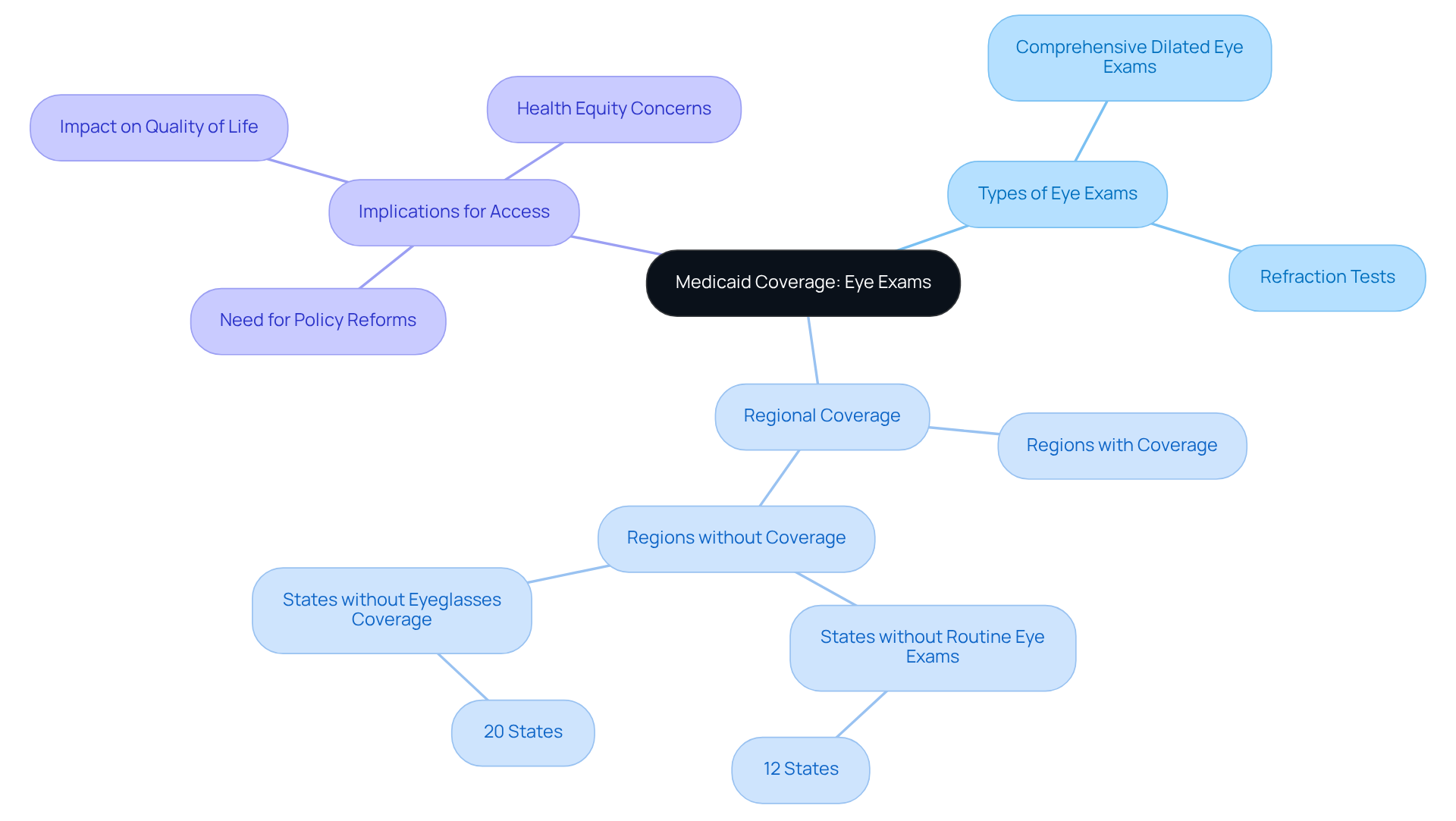
State Variability: How Medicaid Coverage for Eye Exams Differs
The question of whether Medicaid covers eye exams illustrates how health insurance for eye examinations varies significantly across the United States, reflecting how different regions adapt their programs to meet local needs. We understand that navigating these differences can be challenging, especially for those seeking care. Medicaid plays a vital role in providing health and long-term care support to 83 million low-income children and adults, raising the question of whether Medicaid covers eye exams, which greatly influences access to necessary healthcare services.
While some areas offer robust support for regular eye examinations, it is essential to understand whether Medicaid covers eye exams, as others may impose restrictions on the types of exams covered or limit the number of visits. For instance, certain regions might include annual eye examinations for all age groups, while others may only cover specific populations, such as children or individuals with particular health conditions, leading many to ask, does Medicaid cover eye exams? This inconsistency can greatly affect access to essential eye care services.
We encourage you to reach out to your local health assistance program for detailed information about the specific benefits available to you, along with any potential restrictions. Fact sheets containing crucial information about healthcare assistance in each region are available for download, serving as a valuable resource. Understanding these differences is essential to ensure you receive the eye care you need. Remember, we are here to help you through this process.
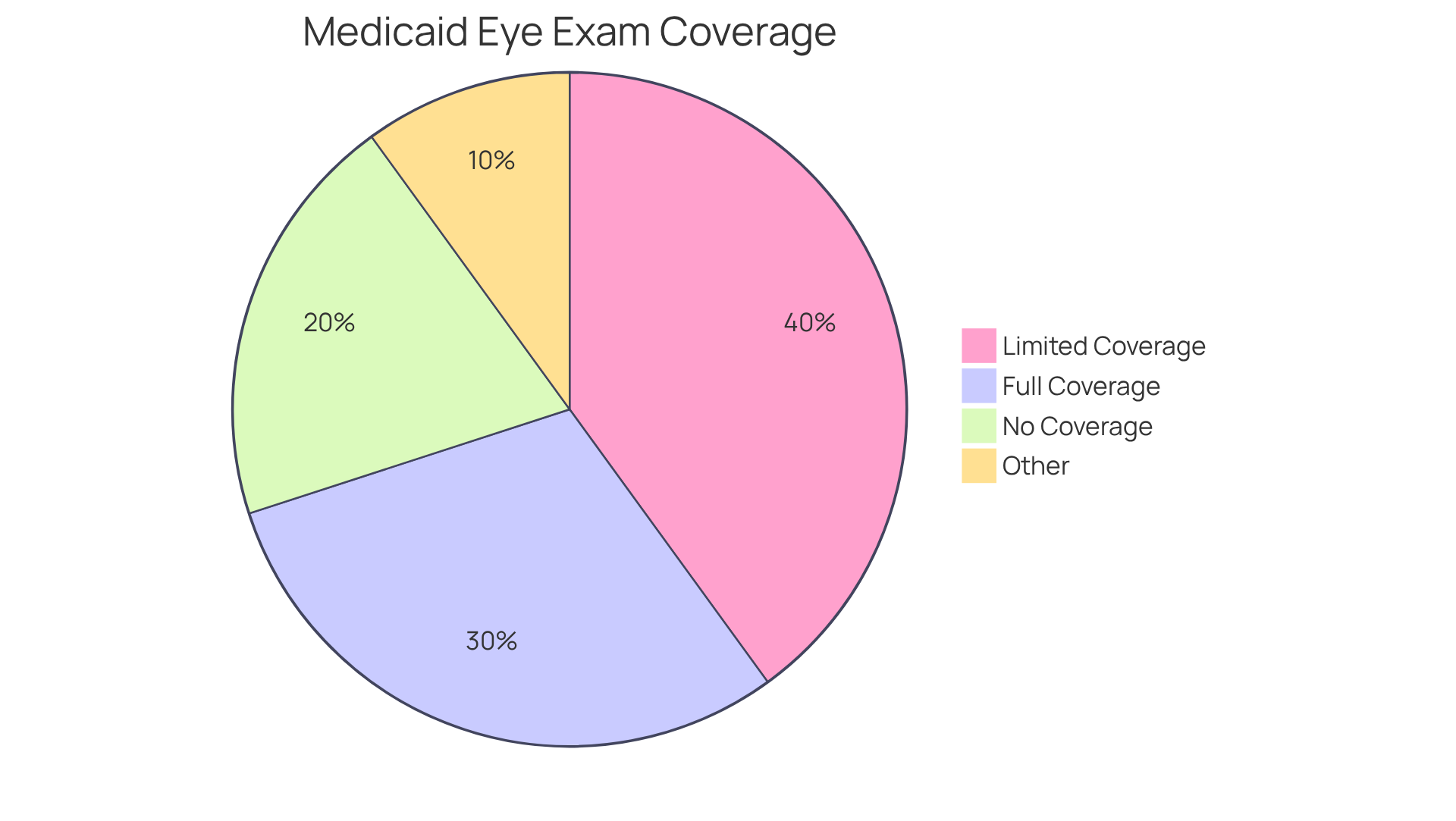
Eligibility Requirements: Who Qualifies for Medicaid Eye Exam Coverage?
Understanding whether Medicaid covers eye exams and the eligibility for these benefits can feel overwhelming, but we’re here to help you navigate this important process. The criteria primarily focus on income limits, residency status, and age. Typically, low-income individuals and families, including children, qualify for coverage, although specific requirements can vary by region. For example, many regions require that adult beneficiaries aged 21 and older have their eye exams covered roughly every two to three years, while children under 21 are entitled to more frequent screenings under the Early and Periodic Screening, Diagnostic, and Treatment (EPSDT) program.
Income thresholds for Medicaid eligibility can differ significantly among regions, with some areas enforcing stricter criteria than others. In California, for instance, the Medi-Cal program reinstated eyeglass assistance for approximately 7 million adults on January 1, 2020, after prior cuts removed this benefit during the Great Recession. This restoration highlights how state-level policies can affect access to vision care. As noted, ‘Eyeglasses, as of the beginning of 2020, are once more covered for approximately 13 million Californians, including 7 million adults, who are part of California’s Medi-Cal program.’
Low-income households often meet the criteria for eye care services, leading to inquiries about whether Medicaid covers eye exams and the provision of essential corrective lenses. It’s essential to consult your state healthcare representatives to obtain accurate information regarding local guidelines and eligibility requirements. As emphasized, “States are required to adhere to the recommended schedule for child and adolescent vision and hearing screenings.” Understanding these factors can significantly impact access to essential vision care, especially for those facing financial challenges.
For additional details on eligibility and benefits, we encourage you to reach out to your local assistance office. We are here to help you through this process.
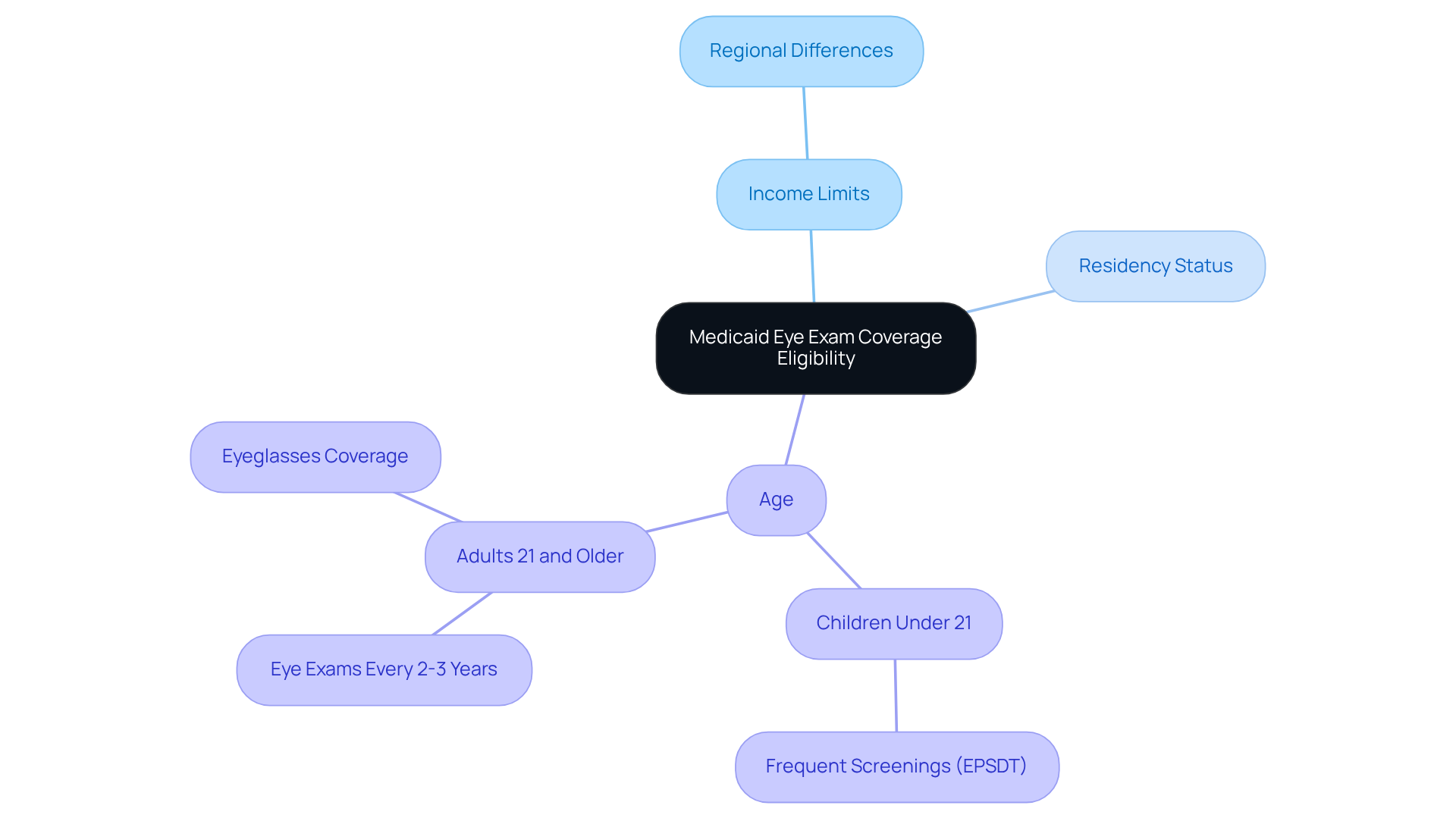
Frequency of Coverage: How Often Does Medicaid Pay for Eye Exams?
This program typically includes eye examinations for both children and adults, leading to inquiries about whether Medicaid covers eye exams, with the frequency of support varying based on age and specific health concerns. For children under 21, we understand that regular eye care is vital. The program usually offers support for eye exams every one to two years, particularly under the Early and Periodic Screening, Diagnostic and Treatment (EPSDT) benefits. This approach ensures that vision issues, such as refractive errors and conditions like amblyopia, are identified and addressed promptly. Left untreated, these issues can lead to serious health complications, and we want to prevent that.
In contrast, adults over the age of 21 typically receive covered eye exams approximately every two to three years. However, it’s important to note that those with certain eye diseases may qualify for more frequent examinations. Significantly, 1.9 million adult fee-for-service participants live in areas that provide coverage for eye exams and eyeglasses each year. We encourage patients to consult their specific health plan and reach out to a representative in their state to understand if Medicaid covers eye exams, the precise details regarding exam frequency, and any additional support for necessary treatments.
Furthermore, it is essential to recognize that there are significant gaps in coverage for routine vision services. These gaps can impact access to necessary eye care, and we are here to help you navigate these challenges. Remember, you are not alone in this journey, and seeking the right support is a crucial step towards maintaining your eye health.
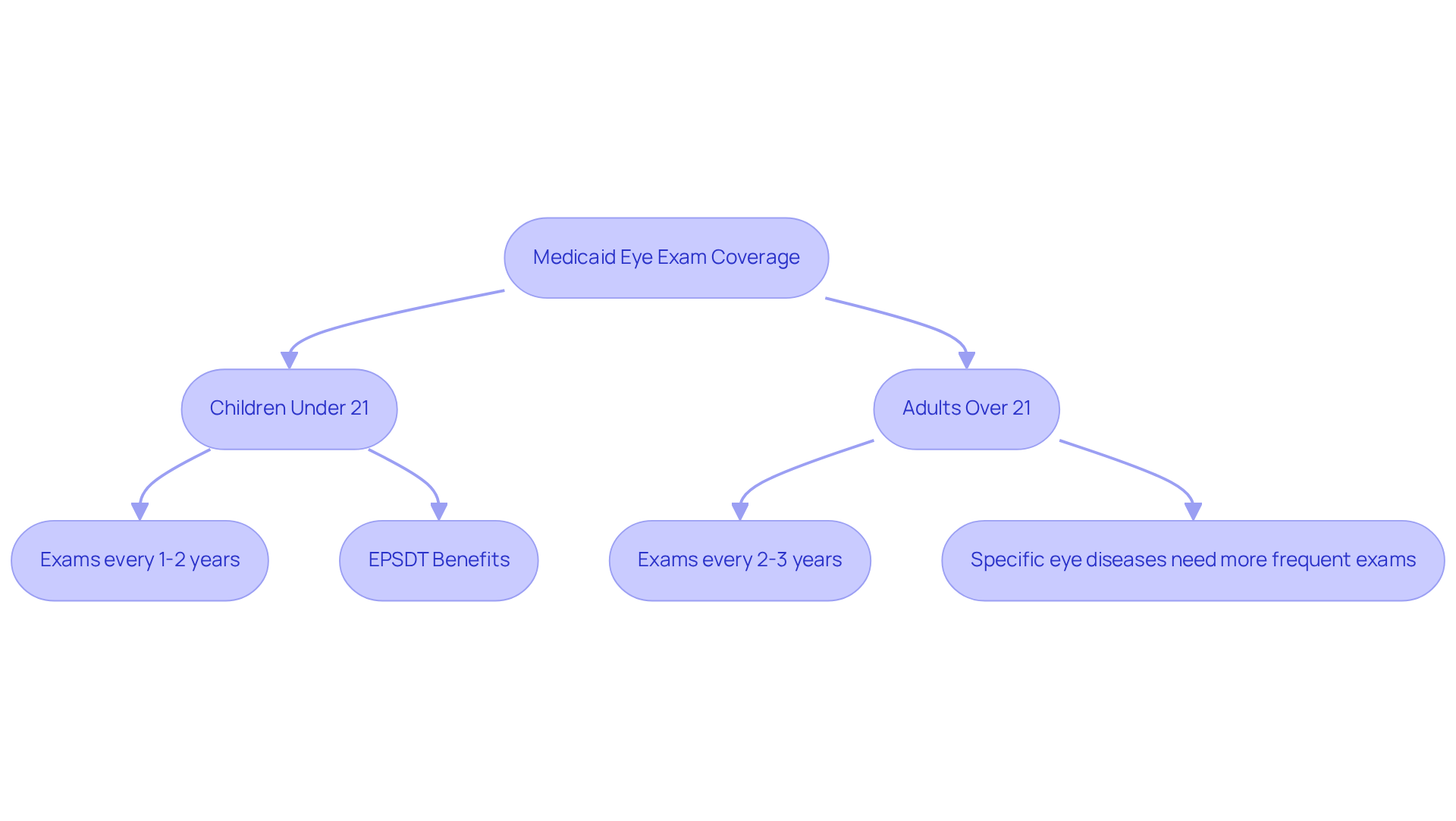
Cost Considerations: What You Might Pay for Eye Exams with Medicaid
While Medicaid generally covers the majority of expenses related to eye exams, we recognize that patients may still ask, does Medicaid cover eye exams fully, given the potential for out-of-pocket costs such as copayments or fees for services not included in their plan. It’s common to feel concerned about these expenses. For example, numerous regions mandate a certain degree of cost-sharing, which can greatly affect access to essential eye care. On average, out-of-pocket costs for an eye exam and eyeglasses can exceed one-third of a single adult’s monthly income if they are living at or below the poverty line.
In terms of specific copayments, we want you to know that fees can vary by state and plan. Some health assistance programs may charge a nominal copayment for eye exams, while others might not impose any fees at all. It’s essential for patients to thoroughly examine their health plan details to understand if Medicaid covers eye exams and the potential expenses they may face during their visits.
Statistics indicate that roughly 6.4 million adult enrollees reside in states lacking extensive support for routine eye exams, which can increase financial burdens. Moreover, nearly 12 million adults aged 40 and older are currently affected by vision impairment, with projections indicating this number will double by 2050. This highlights the significance of comprehending healthcare benefits and the related expenses to guarantee prompt access to eye care services. We are here to help you through this process, ensuring you receive the care you need.
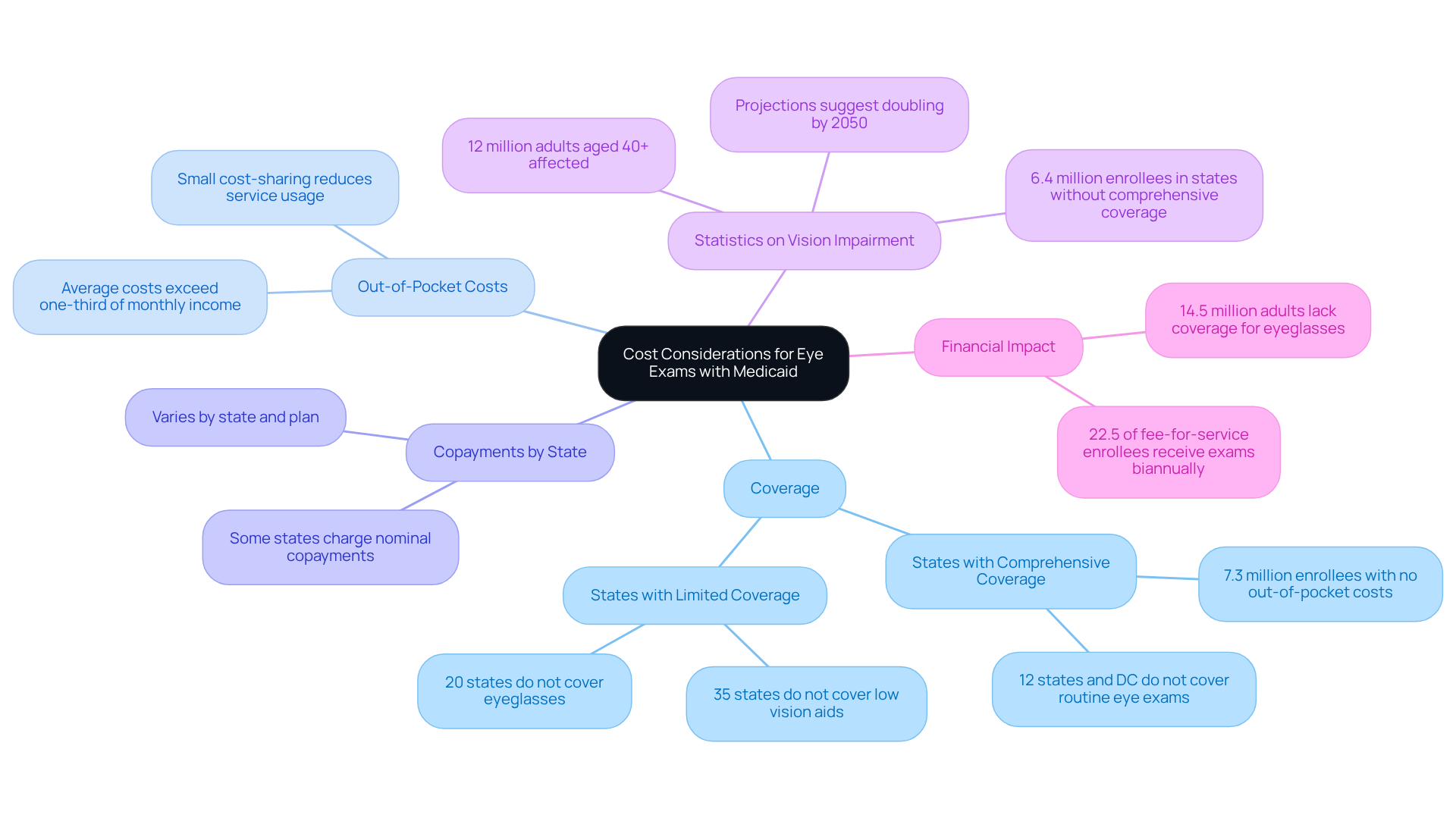
Beyond Exams: Additional Eye Care Services Covered by Medicaid
Health assistance goes beyond routine eye exams, leading many to ask, does Medicaid cover eye exams? It also includes essential eye care services such as treatments for eye diseases and surgical procedures like cataract surgery. At Northwest Eye, we understand the importance of comprehensive eye care. We provide specialized treatments for:
- Cataracts
- Astigmatism
- Glaucoma
- LASIK
This ensures that you receive the highest quality of care tailored to your needs.
We recognize that navigating health insurance can be overwhelming. In many regions, public health insurance covers cataract surgery for qualified individuals, a vital step in restoring vision and enhancing quality of life. However, it’s important to note that about 12% of individuals enrolled in the program live in areas where assistance for routine adult eye examinations is not available, raising the question of whether Medicaid covers eye exams. This highlights the disparities in access to essential eye care services.
Additionally, depending on your specific plan and eligibility criteria, the program may cover optical aids, such as eyeglasses and contact lenses. It is important to check if Medicaid covers eye exams. For instance, if you are under 21, you can benefit from the Early and Periodic Screening, Diagnostic, and Treatment (EPSDT) program, which covers comprehensive eye care, including the costs of eyeglasses. However, we understand that coverage for adults can vary significantly by state; approximately 27% of enrollees reside in states without coverage for eyeglasses.
It is vital for you to review your health insurance plan details to fully understand the range of covered services, including cataract surgery and optical aids. We are here to help you through this process, ensuring you obtain the essential care for your vision requirements.
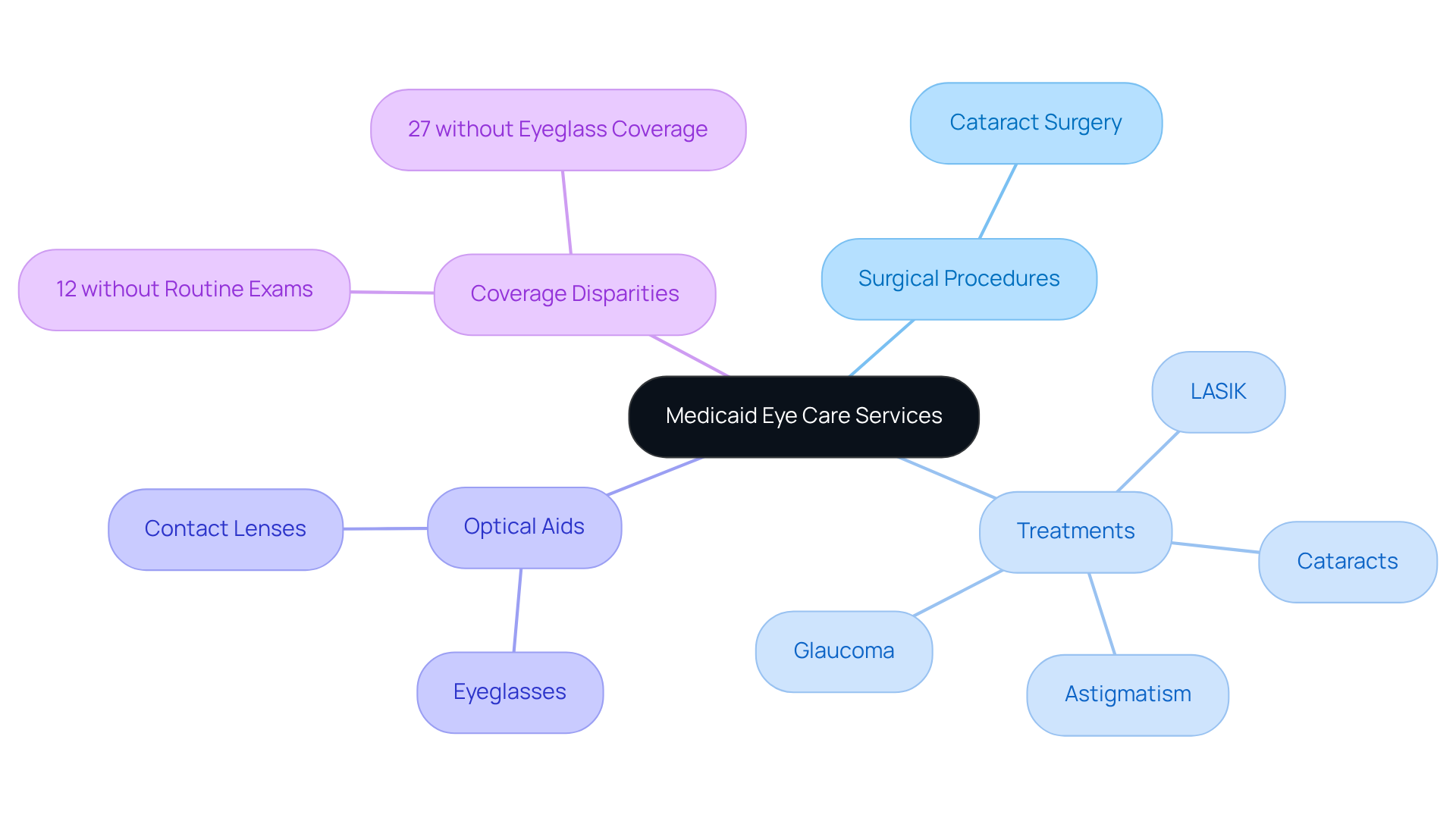
Pediatric Eye Care: Medicaid Coverage for Children’s Eye Exams
The program plays a vital role in ensuring that children receive necessary eye exams, raising the question of whether Medicaid covers eye exams, which are essential for the early detection of vision problems. We understand that as a parent, you may feel concerned about your child’s health. Regular eye exams can uncover conditions such as amblyopia and strabismus, both of which can hinder a child’s development if left untreated.
Statistics show that about 25% of school-aged children experience significant vision issues, yet many do not receive the recommended screenings. It’s common to feel overwhelmed by the healthcare system, but this lack of early intervention can lead to long-term consequences, including amblyopia being a leading cause of single-eye vision loss in adults.
We encourage parents to prioritize these essential exams as part of their child’s healthcare routine, ensuring timely identification and treatment of any potential vision impairments. The program’s coverage for these eye exams brings to light the question of does Medicaid cover eye exams, emphasizing the significance of proactive pediatric eye care and enabling families to access essential services without financial obstacles.
Remember, we are here to help you through this process.
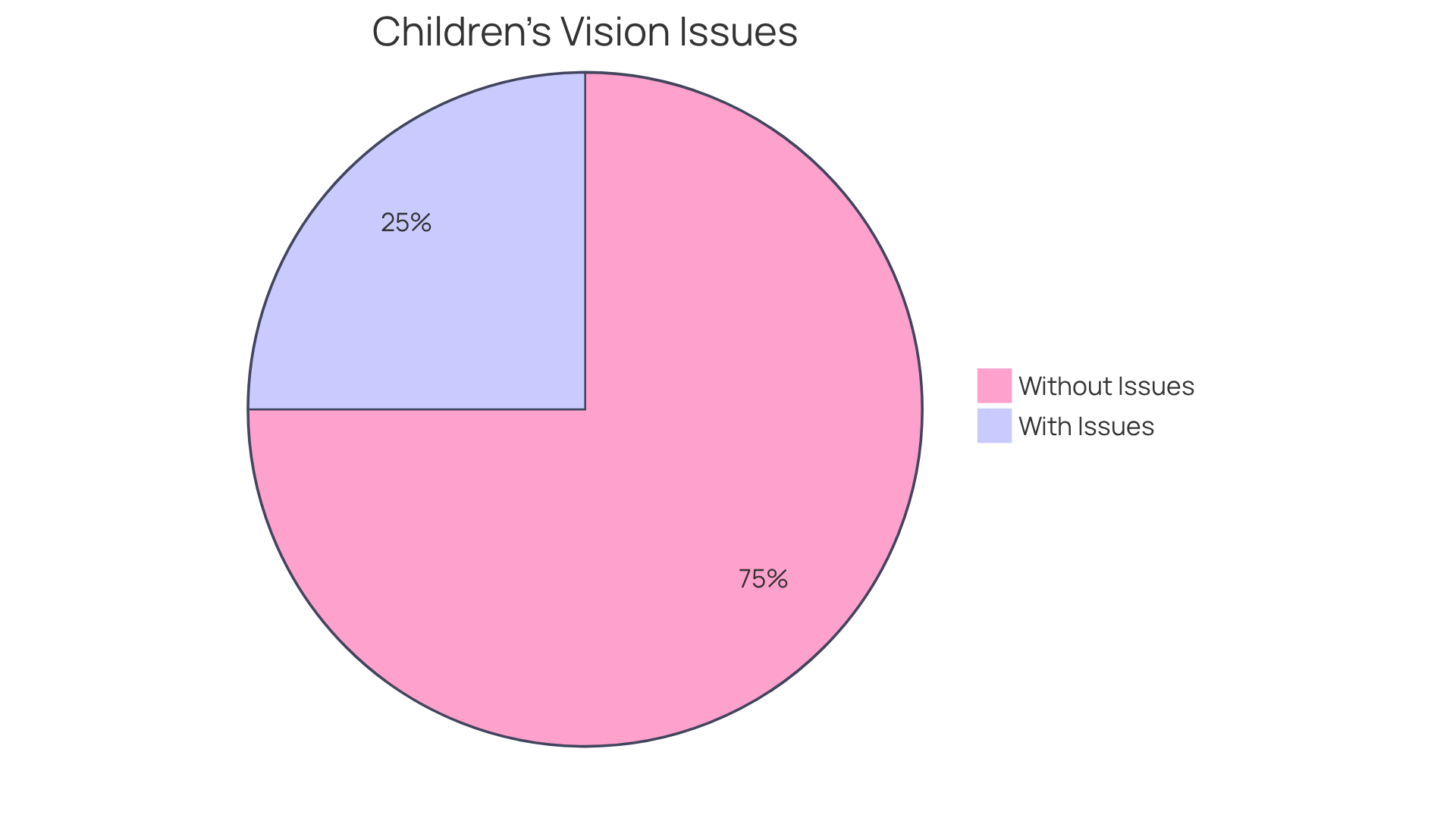
Finding Providers: How to Locate Medicaid-Approved Eye Exam Services
To locate eye exam services approved by the program, we understand that patients may feel uncertain about where to start. You can begin by visiting your state’s healthcare website, which often features a directory of participating providers. Additionally, reaching out to nearby eye care centers, like Northwest Eye, can provide you with valuable information on whether they accept government assistance and the services they offer.
At Northwest Eye, we emphasize the importance of recognizing common eye symptoms, such as blurred vision, which can indicate conditions like cataracts, diabetic retinopathy, dry eyes, and macular degeneration. It’s common to feel apprehensive about these symptoms, but seeking a professional diagnosis from our experienced eye care professionals is crucial for ensuring appropriate treatment.
Furthermore, we are committed to enhancing accessibility across our locations in the Twin Cities, including:
- Golden Valley
- Minnetonka
- Maple Grove
- St. Anthony
- Wayzata
We want to ensure that all patients can receive the eye care they need. We are here to help you through this process. Schedule an appointment today for a general eye examination or to discuss your symptoms and available services.
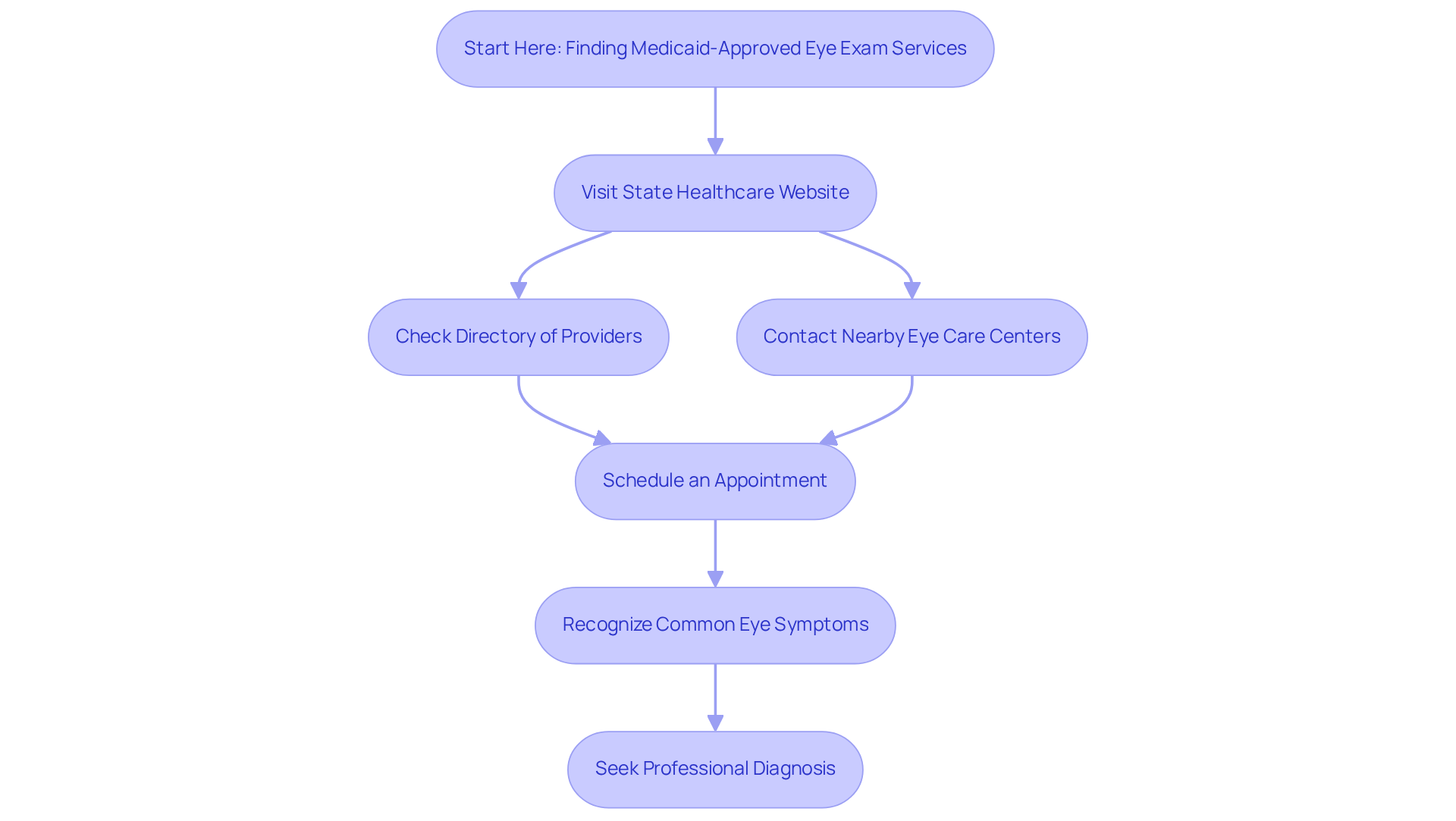
Key Takeaways: Understanding Medicaid Coverage for Eye Exams
Understanding whether Medicaid covers eye exams is vital for patients eager to improve their eye care. Here are some key points to consider:
- Covered Services: Most fee-for-service Medicaid programs offer coverage for routine eye exams. However, there is notable variability in coverage for glasses and low vision aids across different states. Approximately 14.6 million adults lack insurance for glasses, and around 6.5 million adult enrollees live in areas with limited support for routine eye exams. This highlights a significant gap in access to essential vision care.
- Eligibility Requirements: To receive government assistance, patients must meet specific eligibility standards, which can vary by region. It’s crucial for individuals to familiarize themselves with these requirements to ensure they qualify for coverage.
- Frequency of Coverage: The program generally covers routine eye exams annually. However, patients should check the frequency allowed in their area to understand how often does Medicaid cover eye exams in order to maximize their benefits.
- Finding Providers: Patients can find state-approved eye care providers through local health department contacts or state health websites. This ensures they receive the necessary services without incurring out-of-pocket costs.
As Brandy J. Lipton from the University of California Irvine notes, ‘Most fee-for-service programs provided coverage for routine eye exams, raising the question of whether does Medicaid cover eye exams, although many did not include glasses or low vision aids.’ By staying informed about these aspects, patients can navigate their Medicaid benefits effectively and secure the eye care they need. It’s important to be aware of these benefits, especially considering that over 12 million adults aged 40 and older are affected by vision impairment—a number projected to double by 2050. Understanding and utilizing available resources is key to maintaining eye health.
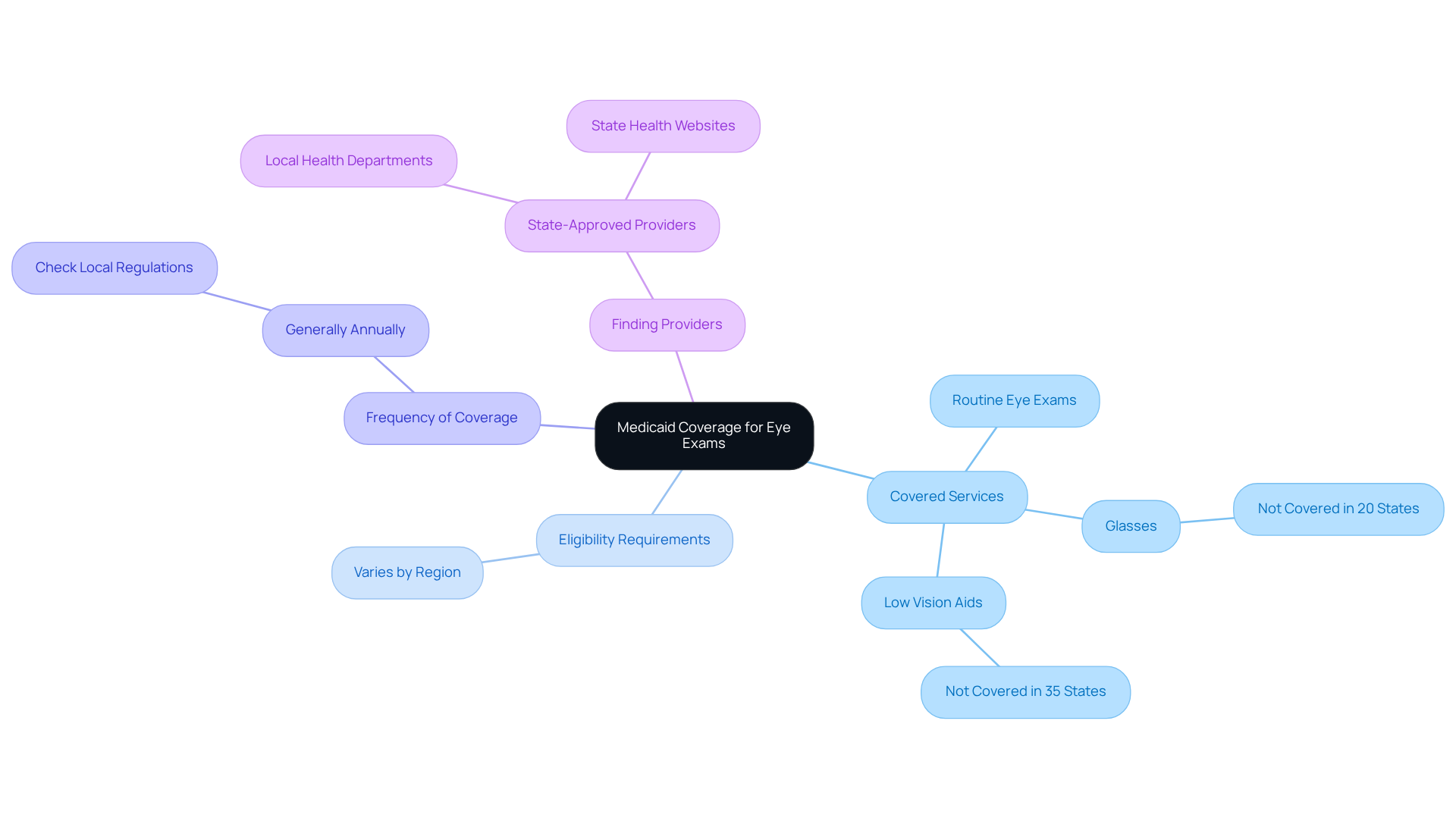
Conclusion
Understanding the nuances of Medicaid coverage for eye exams is crucial for ensuring access to vital eye care services. We understand that navigating these complexities can be overwhelming, and it’s important to be informed about your specific benefits. This article highlights the significant disparities in coverage across different regions, emphasizing the pivotal role Medicaid plays in providing eye care. However, variations in state policies can create barriers to essential services.
Key insights include:
- The types of eye exams covered
- Eligibility requirements
- The frequency of coverage, which can vary based on age and health conditions
It’s common to feel uncertain about what is available to you, but seeking out local resources can help you navigate the complexities of Medicaid benefits effectively.
The significance of understanding Medicaid eye exam coverage cannot be overstated, especially as millions of adults and children face vision impairment. By staying informed and proactive, you can secure the eye care you need, ensuring better health outcomes and a higher quality of life. We encourage you to explore available resources, reach out to local providers, and advocate for necessary services to maintain optimal vision health. Remember, you are not alone in this journey; we are here to help you through this process.
Frequently Asked Questions
What eye care services does Northwest Eye offer?
Northwest Eye offers a wide range of eye care services including comprehensive eye examinations, cataract procedures, therapies for conditions such as glaucoma, dry eye, and astigmatism, LASIK, and specialized care for children.
Does Medicaid cover eye exams?
Medicaid coverage for eye exams varies by region. It typically includes essential vision assessments and screenings for eye diseases, such as comprehensive dilated eye exams and refraction tests, but the availability of these services can differ significantly across areas.
What types of eye exams are generally included under Medicaid?
Medicaid generally covers comprehensive dilated eye exams and refraction tests, which are important for determining the correct prescription for glasses or contact lenses. However, coverage can vary by location.
Are there regions where Medicaid does not cover eye exams?
Yes, some regions lack support for routine adult eye examinations and eyeglasses. For example, a study indicated that 6.5 million individuals in government health programs live in areas without support for routine eye exams, and 14.6 million live in regions without assistance for eyeglasses.
What is the situation regarding refraction tests under Medicaid?
Only a small proportion of regions include refraction tests in their governmental healthcare support, making access difficult for patients needing these evaluations.
How do state policies affect Medicaid coverage for eye exams?
State policies can significantly impact Medicaid coverage for eye exams, with some regions offering comprehensive support while others impose restrictions or limit the types of exams covered, leading to inconsistencies in access to eye care services.
What should I do to understand my Medicaid eye care benefits?
It is essential to reach out to your local health assistance program for detailed information about the specific benefits available to you and any potential restrictions. Fact sheets with crucial information about healthcare assistance in each region are available for download as a resource.






